TLO 2-18
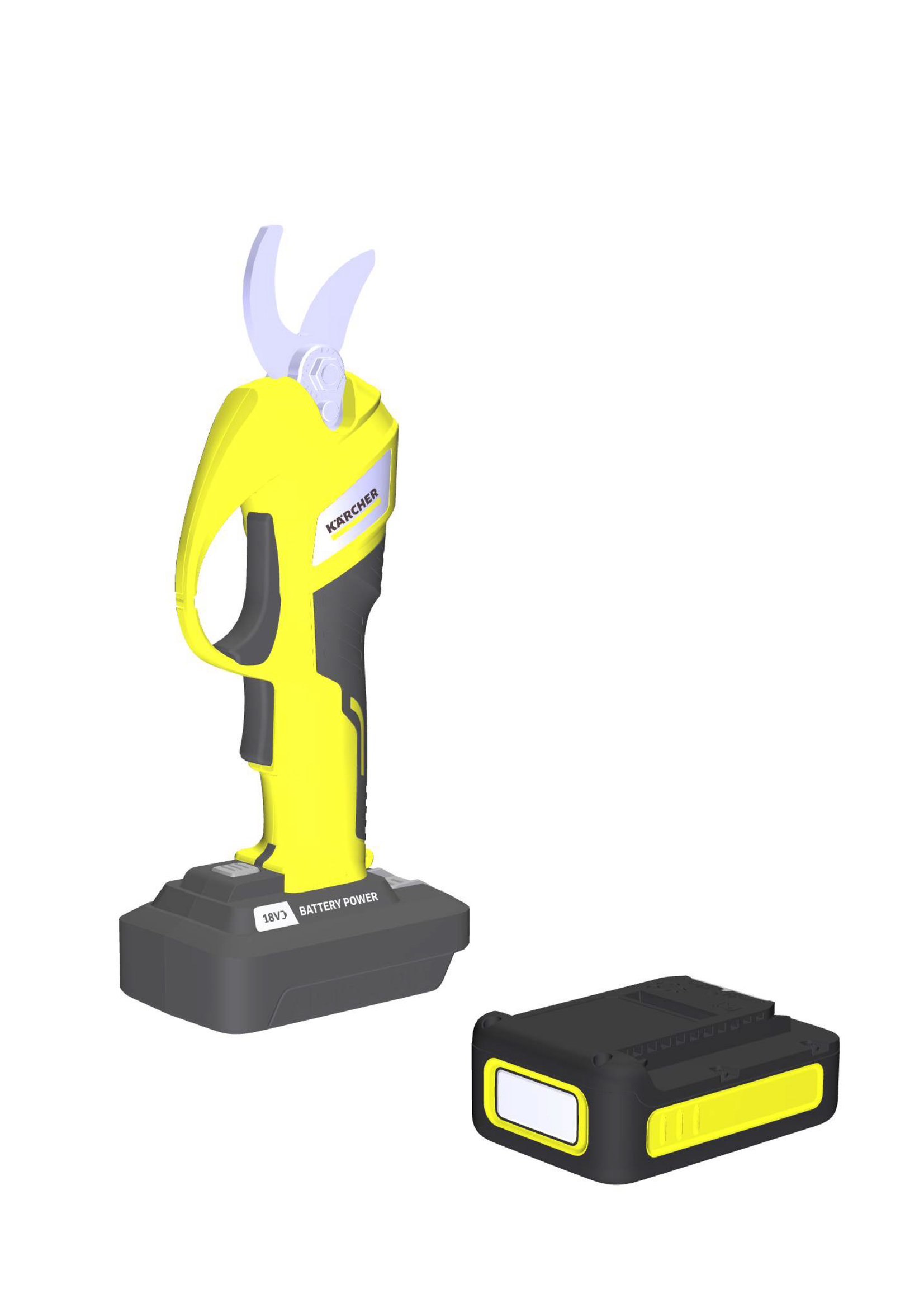
59911000 (08/23)

59911000 (08/23)

59911000 (08/23)
 Read these safety instructions, these original instructions, the safety instructions provided with the battery pack and the original instructions supplied with battery pack/standard charger before using the device for the first time. Act in accordance with them. Keep the booklets for future reference or for future owners.
Read these safety instructions, these original instructions, the safety instructions provided with the battery pack and the original instructions supplied with battery pack/standard charger before using the device for the first time. Act in accordance with them. Keep the booklets for future reference or for future owners.
In addition to the notes in the operating instructions, you also need to take into consideration the general safety regulations and accident prevention guidelines applicable by law.
Indication of an imminent threat of danger that will lead to severe injuries or even death.
Indication of a potentially dangerous situation that may lead to severe injuries or even death.
Indication of a potentially dangerous situation that may lead to minor injuries.
Indication of a potentially dangerous situation that may lead to damage to property.
Read all safety warnings, instructions, illustrations and specifications provided with this power tool.
Failure to follow all instructions listed below may result in electric shock, fire and/or serious injury. Save all warnings and instructions for future reference.
The term "power tool" in the warnings refers to your mains-operated (corded) product or battery-operated (cordless) product.
Work area safety
Keep work area clean and well lit. Cluttered or dark areas invite accidents.
Do not operate power tools in explosive atmospheres, such as in the presence of flammable liquids, gases or dust. Power tools create sparks which may ignite the dust or fumes.
Keep children and bystanders away while operating a power tool. Distractions can cause you to lose control.
Electrical safety
Power tool plugs must match the outlet. Never modify the plug in any way. Do not use any adapter plugs with earthed (grounded) power tools. Unmodified plugs and matching outlets will reduce the risk of electric shock.
Avoid body contact with earthed or grounded surfaces such as pipes, radiators, ranges and refrigerators. There is an increased risk of electric shock if your body is earthed or grounded.
Do not expose power tools to rain or wet conditions. Water entering a power tool will increase the risk of electric shock.
Do not abuse the cord. Never use the cord for carrying, pulling or unplugging the power tool. Keep cord away from heat, oil, sharp edges or moving parts. Damaged or entangled cords increase the risk of electric shock.
When operating a power tool outdoors, use an extension cord suitable for outdoor use. Use of a cord suitable for outdoor use reduces the risk of electric shock.
If operating a power tool in a damp location is unavoidable, use a residual current device (RCD) protected supply. Use of an RCD reduces the risk of electric shock.
Personal safety
Stay alert, watch what you are doing and use common sense when operating a power tool. Do not use a power tool while you are tired or under the influence of drugs, alcohol or medication. A moment of inattention while operating power tools may result in serious personal injury.
Use personal protective equipment. Always wear eye protection. Protective equipment such as dust mask, non-skid safety shoes, hard hat, or hearing protection used for appropriate conditions will reduce personal injuries.
Prevent unintentional starting. Ensure the switch is in the off-position before connecting to power source and/or battery pack, picking up or carrying the tool. Carrying power tools with your finger on the switch or energising power tools that have the switch on invites accidents.
Remove any adjusting key or wrench before turning the power tool on. A wrench or a key left attached to a rotating part of the power tool may result in personal injury.
Do not overreach. Keep proper footing and balance at all times. This enables better control of the power tool in unexpected situations.
Dress properly. Do not wear loose clothing or jewellery. Keep your hair, clothing and gloves away from moving parts. Loose clothes, jewellery or long hair can be caught in moving parts.
If devices are provided for the connection of dust extraction and collection facilities, ensure these are connected and properly used. Use of dust collection can reduce dust-related hazards.
Do not let familiarity gained from frequent use of tools allow you to become complacent and ignore tool safety principles. A careless action can cause severe injury with a fraction of a second.
Power tool use and care
Do not force the power tool. Use the correct power tool for your application. The correct power tool will do the job better and safer at the rate for which it was designed.
Do not use the power tool if the switch does not turn it on and off. Any power tool that cannot be controlled with the switch is dangerous and must be repaired.
Disconnect the plug from the power source and/or remove the battery pack, if detachable, from the power tool before making any adjustments, changing accessories, or storing power tools. Such preventive safety measures reduce the risk of starting the power tool accidentally.
Store idle power tools out of the reach of children and do not allow persons unfamiliar with the power tool or these instructions to operate the power tool. Power tools are dangerous in the hands of untrained users.
Maintain power tools and accessories. Check for misalignment or binding of moving parts, breakage of parts and any other condition that may affect the power tool’s operation. If damaged, have the power tool repaired before use. Many accidents are caused by poorly maintained power tools.
Keep cutting tools sharp and clean. Properly maintained cutting tools with sharp cutting edges are less likely to bind and are easier to control.
Use the power tool, accessories and tool bits etc. in accordance with these instructions, taking into account the working conditions and the work to be performed. Use of the power tool for operations different from those intended could result in a hazardous situation.
Keep handles and grasping surfaces dry, clean and free from oil and grease. Slippery handles and grasping surfaces do not allow for safe handling and control of the tool in unexpected situations.
Battery tool use and care
Recharge only with the charger specified by the manufacturer. A charger that is suitable for one type of battery pack may create a risk of fire when used with another battery pack.
Use power tools only with specifically designated battery packs. Use of any other battery packs may create a risk of injury and fire.
When battery pack is not in use, keep it away from other metal objects, like paperclips, coins, keys, nails, screws or other small metal objects that can make a connection from one terminal to another. Shorting the battery terminals together may cause burns or a fire.
Under abusive conditions, liquid may be ejected from the battery; avoid contact. If contact accidentally occurs, flush with water. If liquid contacts eyes, additionally seek medical help. Liquid ejected from the battery may cause irritation or burns.
Do not use a battery pack or tool that is damaged or modified. Damaged of modified batteries may exhibit unpredictable behaviour resulting in fire, explosion or risk of injury.
Do not expose a battery pack or tool to fire or excessive temperature. Exposure to fire or temperature above 130 °C may cause explosion.
Follow all charging instructions and do not charge the battery pack or tool outside the temperature range specified in the instructions. Charging improperly or at temperatures outside the specified range may damage the battery and increase the risk of fire.
Service
Have your power tool serviced by a qualified repair person using only identical replacement parts. This will ensure that the safety of the power tool is maintained.
Never service damaged battery packs. Service of battery packs should only be performed by the manufacturer or authorized service providers.
Serious injuries due to negligence through familiarity with the device due to frequent use.
Keep the work area clear of bystanders, children and animals while cutting.
Risk of injury if a branch under tension snaps back when cutting.
A sharp cutting edge reduces the risk of injury and increases the cutting performance. Keep the cutting edge sharp and clean, follow the instructions for oiling and replacement of accessory parts.
Check the device for damage before each use and after any impacts. Damaged parts must be repaired or replaced by the authorised Customer Service department.
Immediately stop the device and check for damage or identify the cause of the vibration if the device has been dropped, hit or vibrates abnormally. Have damage repaired by the authorised Customer Service or replace the device.
Danger of injury and damage to the device if unqualified personnel carry out maintenance and care work. Service and maintenance work on this device requires special protective measures and knowledge and may only be carried out by suitably qualified and specially trained specialist personnel.
Risk of injury due to operating error. Keep these operating instructions, read them regularly, and use them for instructing other people how to use the device. Provide these operating instructions with the device when you lend or transfer the device.
Slippery handles and gripping surfaces prevent safe operation and control of the device in unexpected situations. Keep handles and gripping surfaces dry, clean, and free from oil and grease.
Before starting work, the operator must check that all safety devices are attached correctly and are fully functional.
To reduce the risk of fire, personal injury, and product damage due to a short circuit, never immerse the tool, battery back, or charger in fluid or allow fluid to flow inside them. Corrosive or conductive fluids, such as seawater, certain industrial chemicals, and bleach or bleach-containing products, etc., can cause a short circuit.
Charge the battery pack in a location where the ambient temperature is between 10°C and 38°C.
Store the battery pack in a location where the ambient temperature is between 0°C and 40°C.
Use the battery pack in a location where the ambient temperature is between 0°C and 40°C.
Turn off the motor, make sure all moving parts have fully stopped and remove the battery pack before inspecting, cleaning, or servicing the device.
Service and maintenance work on this device require special care and knowledge and may only be performed by appropriately qualified personnel. Take the device to an authorized Customer Service department for maintenance.
Ensure that the device is in a safe condition by regularly checking that all bolts, nuts and screws are screwed tight.
Only use accessories and spare parts and attachments that are approved by the manufacturer. Only original spare parts, original accessories and original attachments ensure fault-free and safe operation of the device.
Injuries and damage to the device when chemicals damage, soften or destroy plastic parts. Avoid contact of plastic parts with brake fluid, petrol, petroleum-based products, rust remover, etc.
Clean the product with a soft, dry cloth each time after use.
Do not use solvents to clean the plastic parts, as they attack the materials used on the device. Remove impurities such as dust, oil and lubricants using a clean cloth.
You may only perform the adjustments and repairs described in these operating instructions. Contact your authorised Customer Service department for other repairs.
In order to ensure a long and reliable service life of the device, you should carry out the maintenance measures described in the operating instructions on a regular basis.
Switch the device off, allow it to cool down and remove the battery pack before storage or transportation.
Risk of injury and damage to the device. Secure the device against movement or falling down during transport.
Remove all foreign bodies from the device before storage or transportation.
Clean the product with a soft, dry cloth each time after use.
Store the device in a dry, well ventilated location out of the reach of children. Keep the device away from corrosive substances such as garden chemicals.
Do not store the device outdoors.
Certain residual risks remain present, even when the device is operated in the prescribed manner. The following dangers can be present when using the device:
Vibration can cause injuries. Use the correct tools for the job, use the handles provided and restrict the working time and hazard exposure time.
Severe injuries through contact with the cutting tools. Keep cutting tools away from hands and feet. Fit the blade guard when not using the device, also during short work breaks.
Injuries caused by hurled objects, e.g. B. wood chips and splinters.
Using the device for longer periods can cause poor circulation in the hands due to vibrations. A general period of use cannot be set, because this depends on several influencing factors:
Personal tendency to suffer from poor circulation (frequently cold fingers, tingling sensation in the fingers)
Low ambient temperature. Wear warm gloves to protect your hands.
Holding the device too tightly hindering blood circulation.
Continuous operation is more harmful than operation interrupted by work breaks.
You should see a doctor if using the device regularly and for lengthy periods of time, and in the event of repeated occurrences of symptoms such as tingling in the fingers or cold fingers.
Improper use
Danger of death from incision injuries
Only use the device for its proper use.
The lopping shears are only intended for private use.
The device is intended for outdoor use only.
The device is intended for cutting and pruning small branches and twigs (for maximum branch thicknesses see Technical data). The user stands securely on the ground.
Any other use, e.g. cutting objects that are not made of wood, is prohibited. The user shall be liable for hazards arising as a result of improper use.
Only use the device with battery packs and chargers from the KÄRCHER 18 V Battery Power (+) system.
 | Suitable battery packs and chargers are marked with the KÄRCHER 18 V Battery Power (+) System symbol. Suitable battery packs bear the designation "Battery Power 18/... and Battery Power+ 18/...". Suitable chargers bear the designation "BC 18 V ...". |
 The packing materials can be recycled. Please dispose of packaging in accordance with the environmental regulations.
The packing materials can be recycled. Please dispose of packaging in accordance with the environmental regulations.
 Electrical and electronic devices contain valuable, recyclable materials and often components such as batteries, rechargeable batteries or oil, which - if handled or disposed of incorrectly - can pose a potential danger to human health and the environment. However, these components are required for the correct operation of the device. Devices marked by this symbol are not allowed to be disposed of together with the household rubbish.
Electrical and electronic devices contain valuable, recyclable materials and often components such as batteries, rechargeable batteries or oil, which - if handled or disposed of incorrectly - can pose a potential danger to human health and the environment. However, these components are required for the correct operation of the device. Devices marked by this symbol are not allowed to be disposed of together with the household rubbish.
Current information on content materials can be found at: www.kaercher.de/REACH
Only use original accessories and original spare parts. They ensure that the appliance will run fault-free and safely.
Information on accessories and spare parts can be found at www.kaercher.com.
The scope of delivery for the appliance is shown on the packaging. Check the contents for completeness when unpacking. If any accessories are missing or in the event of any shipping damage, please notify your dealer.
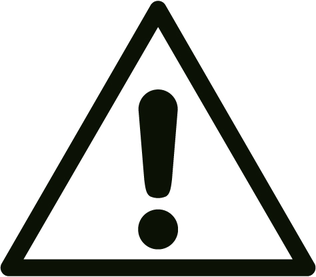 | General warning symbol |
 | Read the operating instructions and all safety instructions before operating the device for the first time. |
 | Wear non-slip, sturdy gloves when working with the device. |
 | Always wear suitable eye protection and hearing protection when working with the device. |
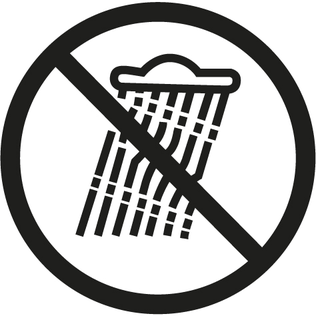 | Do not subject the device to rain or moist conditions. |
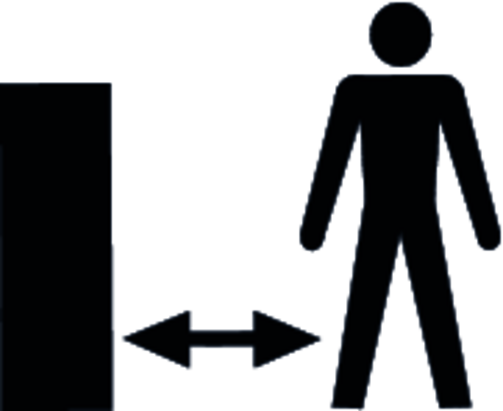 | Danger due to flung objects. Keep spectators, especially children and pets, at least 15 m away from the work area. |
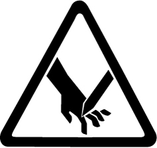 | Attention: sharp blades! Keep your hands away from the blades. |
The maximum amount of equipment is described in these operating instructions. Depending on the model used, there are differences in the scope of delivery (see packaging).
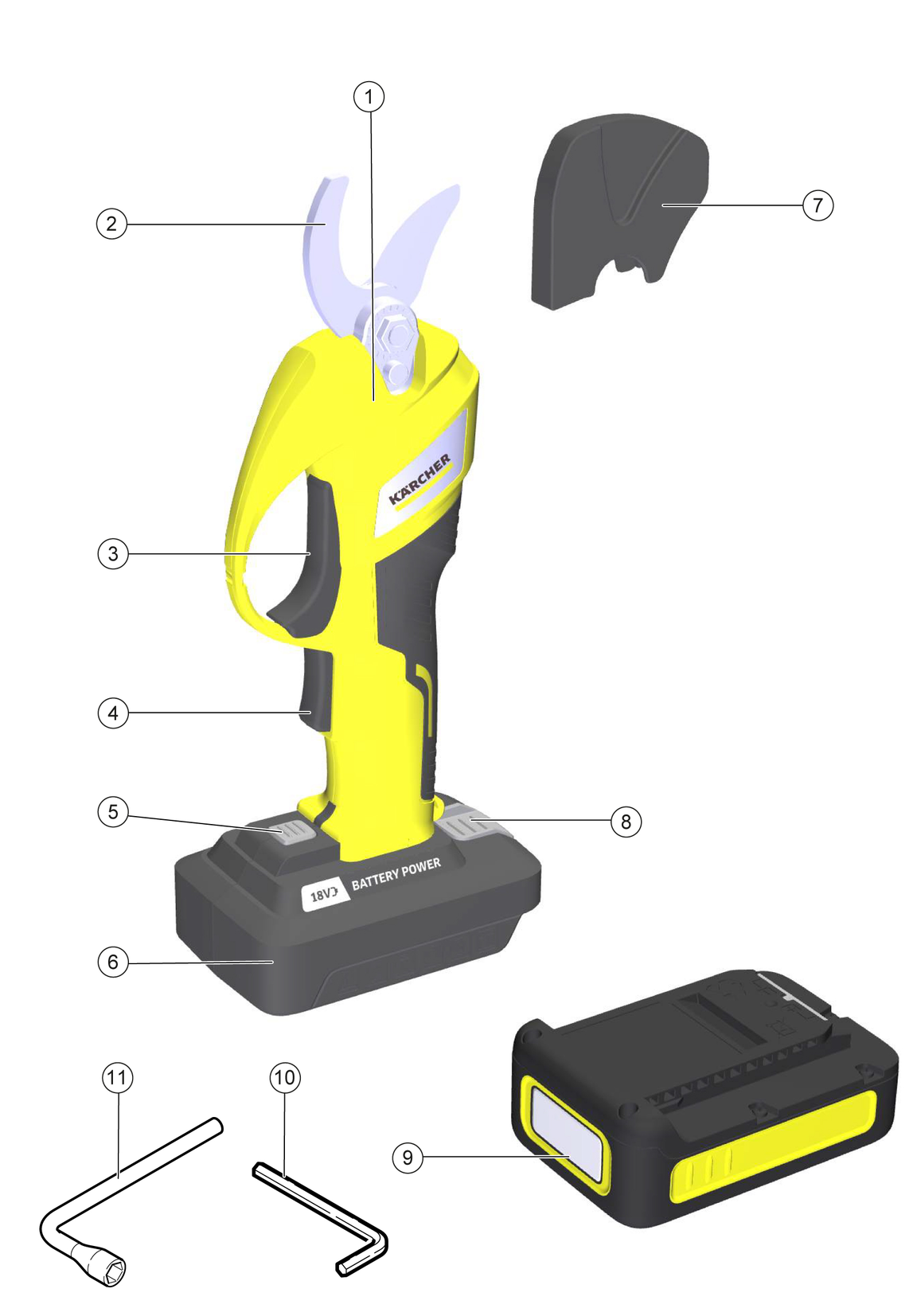
* Not included in the scope of delivery
Push the battery pack mount into the mount of the lopping shears until it audibly latches into place.
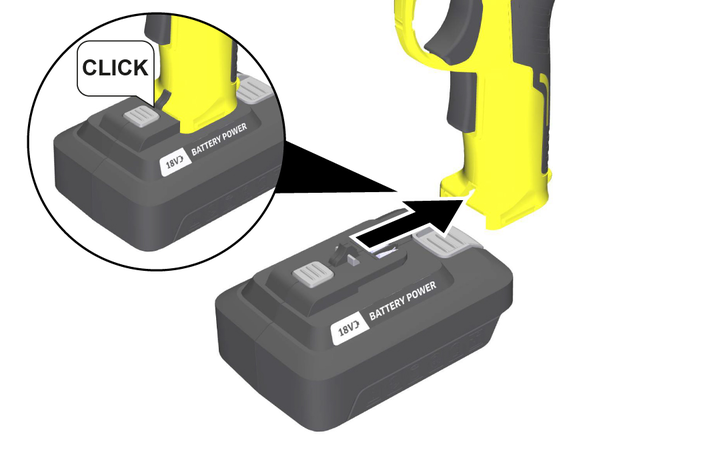
Pay attention to correct seating!
Push the battery pack into the battery pack mount until it audibly latches into place.

Uncontrolled startup
Cutting injuries
Remove the battery from the device before all work on the device.
Make sure that the ON/OFF switch is not activated when inserting the battery pack.
If the device switches off automatically due to overload, release the ON/OFF switch immediately. Wait until the device or the battery pack is ready for operation again before starting it up again.
Remove the blade guard.

Check the tree and the branches to see if any damage such as rot is present or if the branches are under tension.
Hold the device firmly.
Risk of injury!
Risk of injuries from cuts if the distance to the cutting tool is too small.
Make sure that your free hand is at a sufficient distance from the cutting tool.
Press the ON/OFF switch unlocking button.
Press the ON/OFF switch.
The device starts up.
Release the ON/OFF switch.
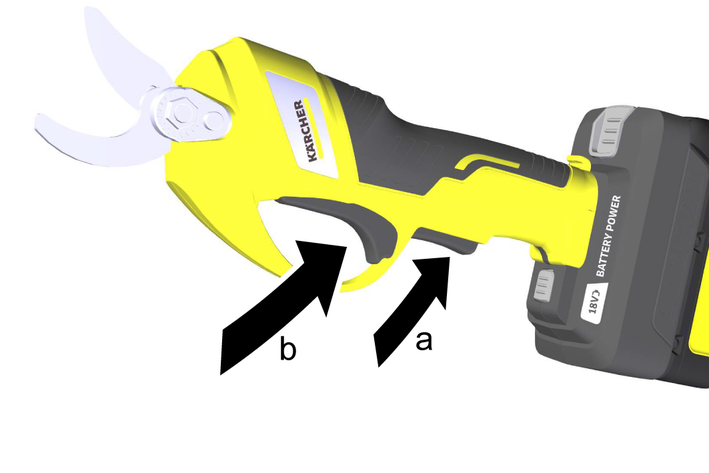
The device stops.
Wood chips or bark can lead to blockage of the cutting blades.
Removing blockages
Incision injuries from the sharp blade or sharp-edged objects
Wear protective gloves when checking for blockages or removing blockages.
Press the ON/OFF switch 3 - 4 times.
If the blockage cannot be removed, proceed as follows:
Remove the battery pack (see chapter Removing the battery pack).
Gently tap the cutting blade with a piece of wood or a rubber mallet until the blockage is released. Keep your hands away from the cutting blades as the blades suddenly open after removing the blockage.
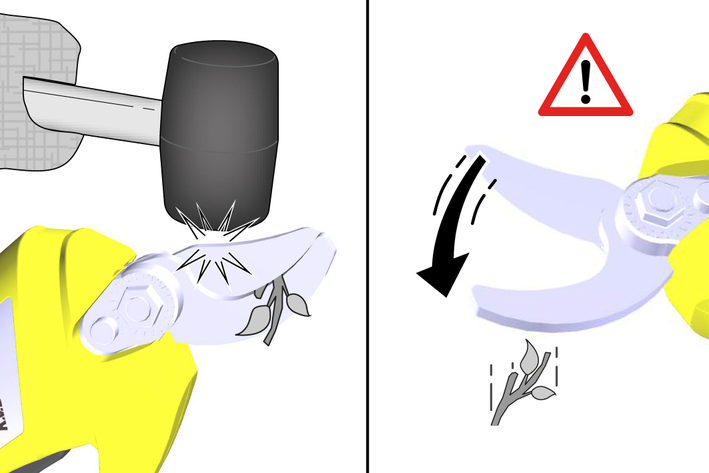
Check that the blades are free to move, if necessary clean foreign bodies from the blades using a brush.
Mount the battery pack (see Chapter Attaching the battery pack mount).
Before further cutting, press the ON/OFF switch to fully open the blades.

The telescopic extension is an optional accessory for cutting wood and branches up to a height of 3.5 m.
Before using the telescopic extension, read its operating instructions.
During longer work breaks, remove the battery pack from the device and secure it against unauthorised use.
Press the battery pack unlocking button to unlock the battery pack.
Remove the battery pack from the device.
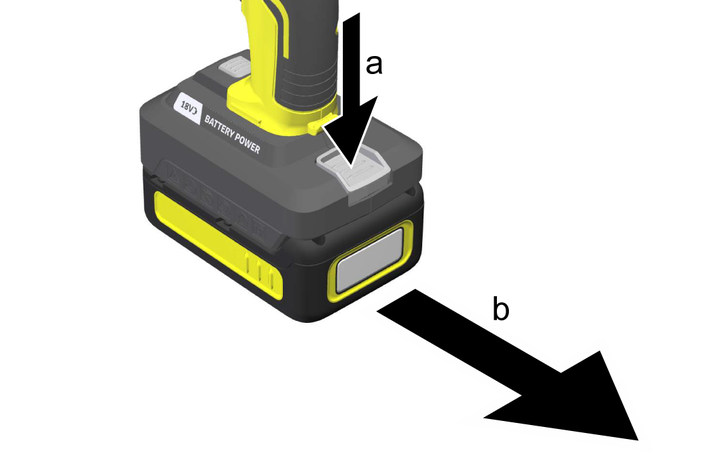
Remove the battery pack from the device (see Chapter Removing the battery pack).
Clean the device (see Chapter Cleaning the device).
Failure to observe the weight
Risk of injury and damage
Be aware of the weight of the device during transportation.
Uncontrolled startup
Incision injuries
Remove the battery pack from the device before transport.
Transport the device only with the blade guard fitted.
Secure the device against slipping and tipping over when transporting in vehicles.
Always clean the device before putting it into storage (see Chapter Cleaning the device).
Failure to observe the weight
Risk of injury and damage
Be aware of the weight of the device during storage.
Uncontrolled startup
Incision injuries
Remove the battery pack from the device before storage.
Store the device only with the blade guard fitted.
Fit the blade guard.
Store the device in a dry, well ventilated location. Keep away from corrosive substances such as garden chemicals and defrosting salt. Do not store the device outdoors.
Uncontrolled startup
Incision injuries
Remove the battery from the device before all work on the device.
Sharp cutting blade
Incision injuries
Wear protective gloves when working on the cutting blade.
Improper cleaning
Damage to the handle housing
Do not use solvents to clean the handle housing.
Use clean cloths to remove contaminants such as dust, oil or lubricants.
Contact with chemicals
Damage to plastic parts
Do not leave the plastic parts with chemicals such as B Brake fluid, gasoline, petroleum-based products or rust remover in contact.
Remove the battery pack (see Chapter Removing the battery pack).
Use a brush to remove any dirt and debris from the cutting blade.

Clean the handle housing with a soft, dry cloth.
In order to maintain the cutting blade quality, the cutting blade sections should be oiled after each use.
Using thin machine oil or spray oil will yield very good results.
Place the device on a flat surface.
Apply the oil to the cutting blade.
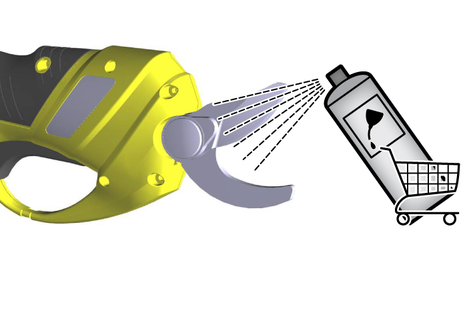
Before each startup, the following maintenance activities must be carried out:
Check the device for damage.
Check all bolts, nuts and screws for tightness; re-tighten if necessary.
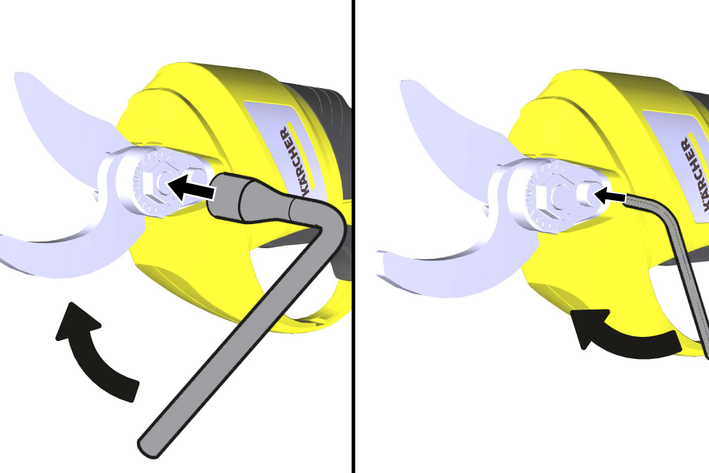
Check the sharpness of the cutting blade. Replace blunt cutting blade.
Malfunctions often have simple causes that you can remedy yourself using the following overview. When in doubt, or in the case of malfunctions not mentioned here, please contact your authorised Customer Service.
As the battery pack ages, even if it is looked after, its capacity reduces such that the full run time will no longer be reached when fully charged. This does not indicate a defect.
The device does not start up
Cause:
Battery pack is empty
Remedy:
Charge the battery pack.
The device does not start up
Cause:
Battery pack is defective.
Remedy:
Replace the battery pack.
The device does not start up
Cause:
Battery pack is not inserted correctly.
Remedy:
Push the battery pack into the mounting until it latches into place.
The device stops during operation
Cause:
Cutting blade blocked by clippings.
Remedy:
Remove the clippings.
The device stops during operation
Cause:
The battery has overheated
Remedy:
Stop working and allow the battery to cool down to normal battery temperature.
The device stops during operation
Cause:
Motor has overheated
Remedy:
Stop working and allow the motor to cool down.
The warranty conditions issued by our sales company responsible apply in all countries. We shall remedy possible malfunctions on your device within the warranty period free of cost, provided that a material or manufacturing defect is the cause. In a warranty case, please contact your dealer (with the purchase receipt) or the next authorised customer service site.
You can find more detailed information at: www.kaercher.com/dealersearch
Device performance data | |
Working voltage of the battery | 18 V |
Cut material diameter (max.) | 25 mm |
Determined values in acc. with EN 62841-1 | |
Sound pressure level LpA | 67 dB(A) |
Uncertainty KpA | 3 dB(A) |
Sound power level LwA | 75 dB(A) |
Uncertainty KWA | 3 dB(A) |
Handle hand-arm vibration value | 1,6 m/s2 |
Uncertainty K | 1,5 m/s2 |
Dimensions and weights | |
Length x width x height | 320 x 89 x 135 mm |
Weight (without battery pack) | 1,1 kg |
The specified vibration value was measured using a standard test procedure and may be used to compare devices.
The specified vibration value may be used in a provisional assessment of the load.
Depending on the way the device is used, the vibration emission can deviate from the specified overall value during the current use of the device.
Uninterrupted use of the device for several hours can lead to numbness.
Wear warm gloves to protect your hands.
Take regular breaks from work.
EU Declaration of Conformity |
We hereby declare that the machine described below complies with the relevant basic safety and health requirements in the EU Directives, both in its basic design and construction as well as in the version placed in circulation by us. This declaration is invalidated by any changes made to the machine that are not approved by us.
Product: Battery-powered lopping shears
Type: TLO 2-18
Currently applicable EU Directives2006/42/EC (+2009/127/EC)
2011/65/EU
2014/30/EU
Harmonised standards usedEN 55014-1: 2017 + A11: 2020
EN 55014-2: 1997 + A1: 2001 + A2: 2008
EN 60745-1:2009+A11:2010
EN IEC 63000: 2018
EN ISO 12100: 2010
The signatories act on behalf of and with the authority of the company management.

Documentation supervisor:
S. Reiser
Alfred Kärcher SE & Co. KG
Alfred-Kärcher-Str. 28 - 40
71364 Winnenden (Germany)
Ph.: +49 7195 14-0
Fax: +49 7195 14-2212
Winnenden, 2023/08/01
Declaration of Conformity (UK) |
We hereby declare that the product described below complies with the relevant provisions of the following UK Regulations, both in its basic design and construction as well as in the version put into circulation by us. This declaration shall cease to be valid if the product is modified without our prior approval.
Product: Battery-powered lopping shears
Type: TLO 2-18
Currently applicable UK RegulationsS.I. 2008/1597 (as amended)
S.I. 2012/3032 (as amended)
S.I. 2016/1091 (as amended)
Designated standards usedEN 55014-1: 2017 + A11: 2020
EN 55014-2: 1997 + A1: 2001 + A2: 2008
EN 60745-1:2009+A11:2010
EN IEC 63000: 2018
EN ISO 12100: 2010
The signatories act on behalf of and with the authority of the company management.

Documentation supervisor:
S. Reiser
Alfred Kärcher SE & Co. KG
Alfred-Kärcher-Str. 28 - 40
71364 Winnenden (Germany)
Ph.: +49 7195 14-0
Fax: +49 7195 14-2212
Winnenden, 2023/08/01
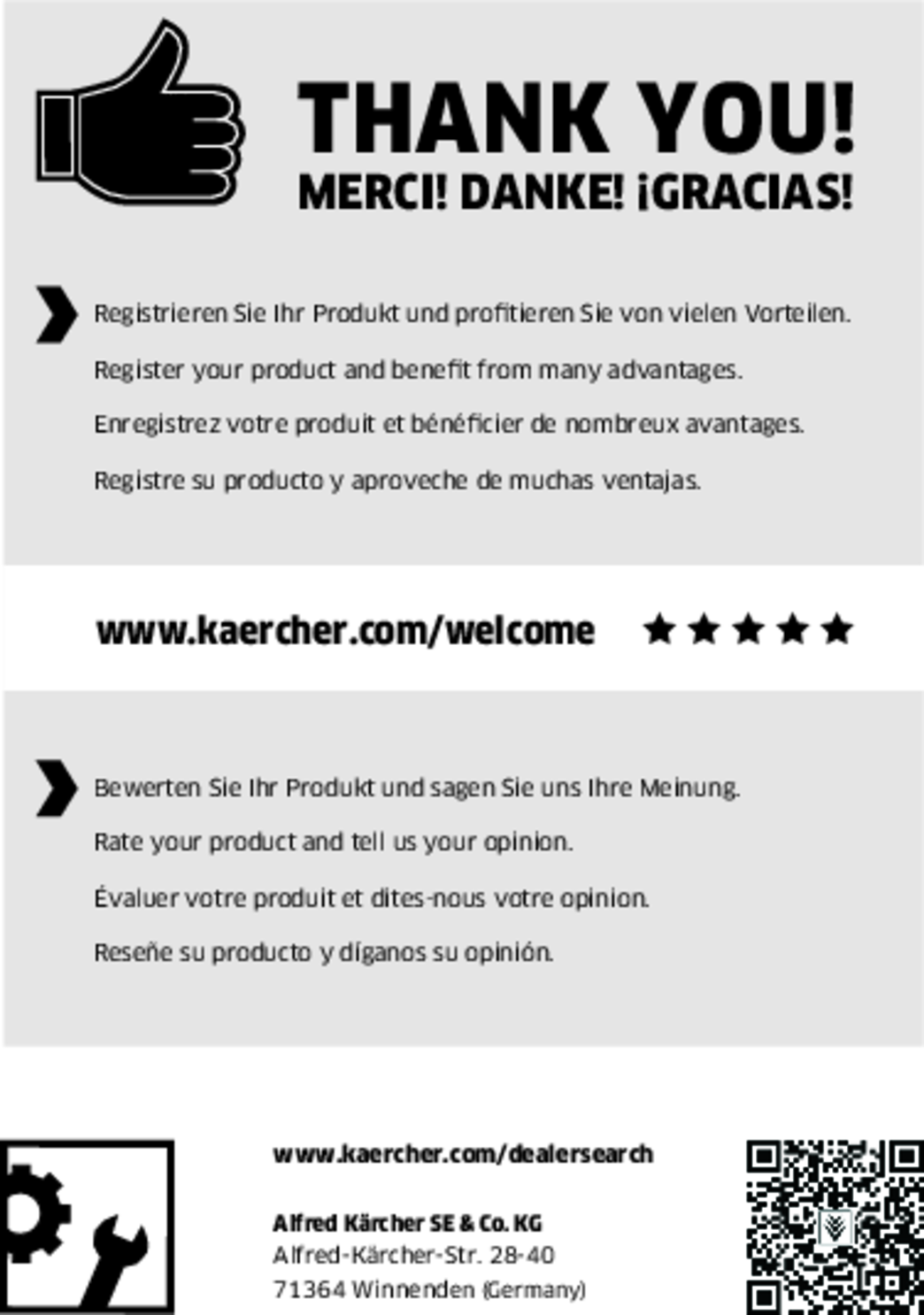
2-2-SC-A5-GS-12579